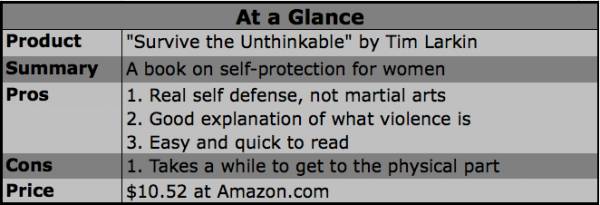
It’s always been a major pet peeve of mine that when people find out I’ve studied martial arts, they immediately assume I’ve done so for self-defense reasons. This is annoying because A) I did not ever study martial arts for self-defense and B) neither wushu, nor staff fighting, nor any of the other martial arts I’ve studied would be at all useful for self-defense, in my opinion – and I include Brazilian jiu jitsu and muay Thai in that grouping, too, by the way.
Real self-defense is a thing unto itself. It’s not about techniques or combinations, it’s not about sparring, and it’s not about whatever scenario some McDojo owner is trying to convince you might happen so that you’ll sign up for a special class. Real self-defense is mostly about protection and prevention and only a little bit about physical confrontation. It’s about awareness and learning to tune in to the world around you.
Building that awareness is a large part of the book Survive the Unthinkable: A Total Guide to Women’s Self-Protection by Tim Larkin. (Notice Larkin calls it “self-protection” right off the bat – not self-defense.) Larkin runs the company Target Focus Fitness, and training combat and protection techniques to everyone from Navy SEALs to soccer moms has been his domain for almost twenty years.
It’s hard to emphasize enough just how important people like Larkin and books like his are. To give you an idea, check out these quotations and stats from the book:
- “Women ages 15 through 44 are more likely to die or be maimed because of male violence than because of cancer, malaria, war, and traffic accidents combined.”
- “Only 16 percent of rape victims actually report an incident to the police.”
- “The World Health Organization has found that domestic and sexual violence affects 30 to 60 percent of women in most countries.”
- “The rape perpetrator will probably victimize seven to nine women before he’s jailed.”
So what does the average woman do about this situation? That’s the question Survive the Unthinkable aims to answer. A large portion of the book is dedicated to defining violence, explaining the only useful answer to violence (bigger, badder violence), and helping us understand why we have an aversion to protecting ourselves properly in the first place. And basically, that boils down to the idea that most of us are civilized people – but truly bad guys are not. Even in awful situations, we somehow still expect bad guys to play by society’s rules. Larkin discusses in detail why this is not so, why it does not work, and how the only way to come out the other end alive is to think like an even more brutal predator yourself. It’s not a comfortable concept, but I believe Larkin is completely right. As Larkin explains it, “Violence is rarely the answer, but when it is, it’s the only answer.”
My husband and I are always careful when we’re out, but we’ve both remarked that we’d have zero qualms beating the snot out of anyone who came at either of us physically. But I also believe this is why things don’t happen to us in the first place. Just as Gavin de Becker explained in Gift of Fear, Larkin’s goal is not to have you understand violence so that you will be paranoid and anxious in your life. Rather, the goal is the opposite – that you have an understanding of how the world of predators works, you make better choices, and you feel confident that you can protect yourself if things go wrong, and therefore the likelihood of things going wrong decreases. Throughout the book, Larkin’s strives to help you become more in touch with your instincts and senses so that you recognize danger signals, but you also don’t invent them where they don’t exist or escalate situations for no reason.
When it comes to the physical part of self-protection, that comes late in this book. It is hinted at throughout, and if I had to say a negative about this book I would say that constantly teasing that portion got a little old. But the problem with real self-defense is that the physical part just isn’t that glamorous compared to martial arts, which is why it doesn’t sell as well. So the instructions on how to attack a predator do come late, but they are straightforward and make sense. Not only that, but there’s some actual science about the human nervous system that Larkin uses as the basis for his system.
To summarize the entire physical portion of Larkin’s self-protection system, I’ll just quote him: “Break things about the person so they don’t work and can’t harm you.” And it really is that simple, which it needs to be for you to execute it in an actual critical situation. The information in this book is not complicated, and there is nothing that shouldn’t be there or that could be called bad advice. This book only has good, solid information that could literally save the life of someone you love.
While this book is intended for women, I think anyone could read it and get plenty out of it. There is much discussion about social interactions and needless escalation of arguments that would be applicable to many people I know, of both sexes. This book is not expensive and it’s a quick and easy read. If you have people in your life who you care about, consider purchasing a copy of this book and passing it around. If nothing ever happens to anyone you love, that’s a wonderful thing. But if something should happen, having read a book like this could make a world of difference.
“Survive the Unthinkable” is available for $10.52 at Amazon.com.






